November 2025
The global photoinitiator market size was estimated at USD 147.19 million in 2024 and is predicted to increase from USD 162.28 million in 2025 to approximately USD 390.54 million by 2034, expanding at a CAGR of 10.25% from 2025 to 2034. The increasing demand for UV curable materials from various industries like coatings, inks, and adhesives, and the shift towards the use of eco-friendly alternatives due to the shift towards sustainability and the use of low VOC-formulations, drives the growth of the market.
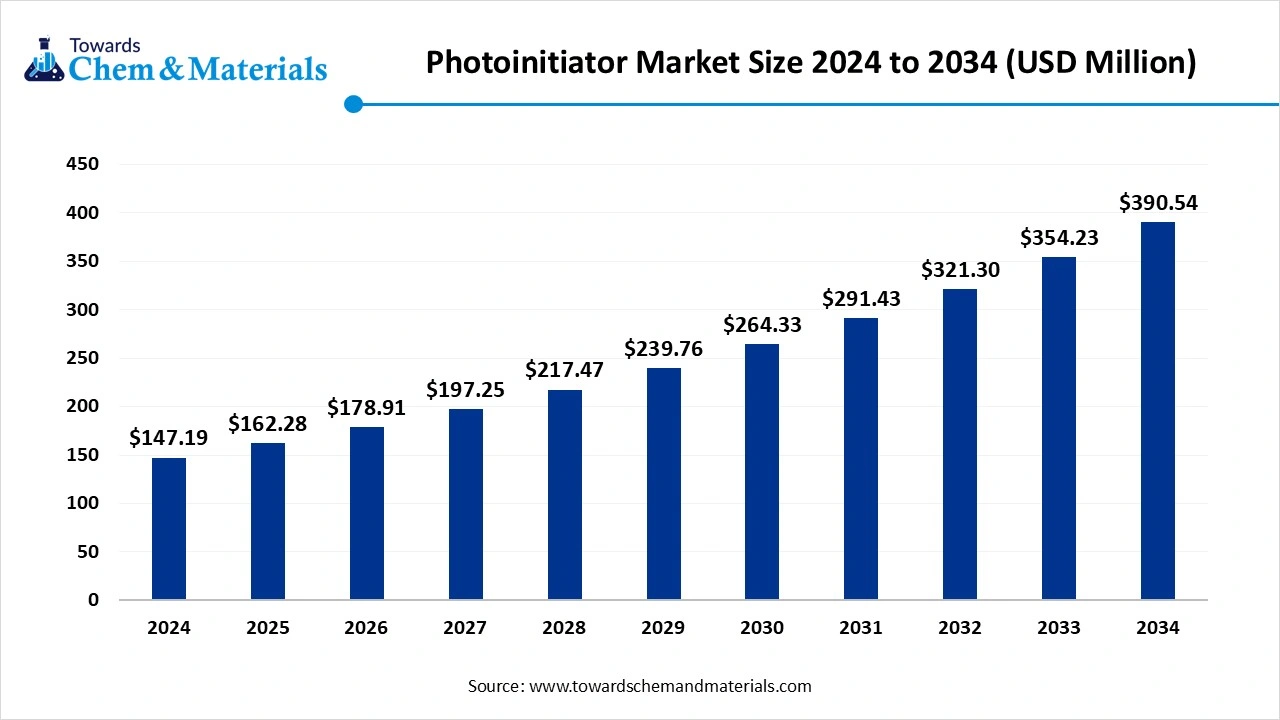
Rising Demand for Durable Materials: Photoinitiator Market to Expand
Photoinitiators are molecules that initiate chemical reactions when exposed to light. They're designed to absorb light at specific wavelengths, usually in the ultraviolet (UV) or visible spectrum. When they absorb light, the photoinitiator molecule transitions into an excited state. This excited state can then undergo various processes, such as breaking apart, abstracting a hydrogen atom, or transferring an electron, to generate reactive species like radicals, cations, or anions. These reactive species then trigger further chemical reactions, such as polymerization, crosslinking, or degradation, depending on the system. In short, the photoinitiator absorbs photons (light energy) and becomes excited, leading to the formation of reactive species that trigger further reactions, often polymerization, the process of forming large molecules from smaller units. Photoinitiators play a crucial role in various technologies, including UV-curable inks, coatings, adhesives, and dental materials.
The growth of the photoinitiator market is driven by the growing demand for UV curing materials like coatings, inks, and adhesives from various industries like electronics, automotives, and packaging industries drives the growth of the market. The growing use of eco-friendly and energy-efficient materials, which offer more sustainable alternatives to traditional solvent-based systems, has a lower environmental impact by reducing VOC emissions and energy consumption, fueling the growth of the market. The driven demand for increasing production efficiency increases the demand for materials having faster curing times, like UV-cured coatings, inks, and adhesives boosts the growth of the market. Other drivers responsible for the growth of the market are technological advancements, growing industries, stringent environmental regulations, superior performance, and a wide range of applications high performance solutions in various industries, which boost the growth and expansion of the market.
| Report Attributes | Details |
| Market Size in 2025 | USD 162.28 Million |
| Expected Size by 2034 | USD 390.54 Million |
| Growth Rate from 2025 to 2034 | CAGR 10.25% |
| Base Year of Estimation | 2024 |
| Forecast Period | 2025 - 2034 |
| Dominant Region | North America |
| Segment Covered | By Type, By End Use, By region |
| Key Companies Profiled | IGM Resins, Lambson Ltd (part of Aditya Birla Group), Arkema S.A., BASF SE, Tronly New Electronic Materials Co., Ltd., Tianjin Jiuri New Materials Co., Ltd., ADEKA Corporation, Evonik Industries AG, Rahul Photoinitiators Pvt. Ltd., Eutec Chemical Co., Ltd. |
What Are the Key Opportunities Responsible for The Growth of The Photoinitiator Market?
The key growth opportunity responsible for the growth of the market is the advancements in 3D printing, like photoinitiators play a vital role in additive manufacturing, particularly in 3D printing techniques such as stereolithography and digital light processing, where they enable rapid curing and the formation of intricate, customized structures. In the field of bioprinting, advanced photoinitiators are being developed to support applications in tissue engineering and regenerative medicine. Additionally, they are crucial in printed electronics, including flexible circuits and RFID tags, where fast and accurate curing processes are essential for high-performance outcomes, which creates an opportunity for the growth of the market and boosts the growth of the market.
The Technical Limitations, Cost, and Price Volatility
The limitation in technical handling and the cost of the raw materials a challenge that hinders the growth of the market. The fast curing requires high technical handling and processing, and this can lead to technical errors like depth curing issues, oxygen inhibition, which limits the use in certain applications. Along with this, the fluctuation in raw material prices, which affects the profitability of the market, is also a challenge in the market, hindering the growth of the market.
How Did North America Dominate the Photoinitiator Market in 2024?
The North America photoinitiator market is expected to increase from USD 58.03 million in 2025 to USD 139.85 million by 2034, growing at a CAGR of 10.26% throughout the forecast period from 2025 to 2034. North America dominated the photoinitiator market in 2024. The growth of the market is driven by the strong industrial sector in the region, like packaging, printing, and coating, which fuels the growth of the market in the region. The region is also advancing in technology, like the development of high-performance inks and coating materials, with innovation in 3D printing also boosting the growth of the market. The other industries, such as automotive, electronics, and healthcare, also demand coatings, inks, and adhesives, and demand for advanced materials for protection and appearance due to the growing automotive sector in the region, which fuels the growth of the market and also supports the growth.
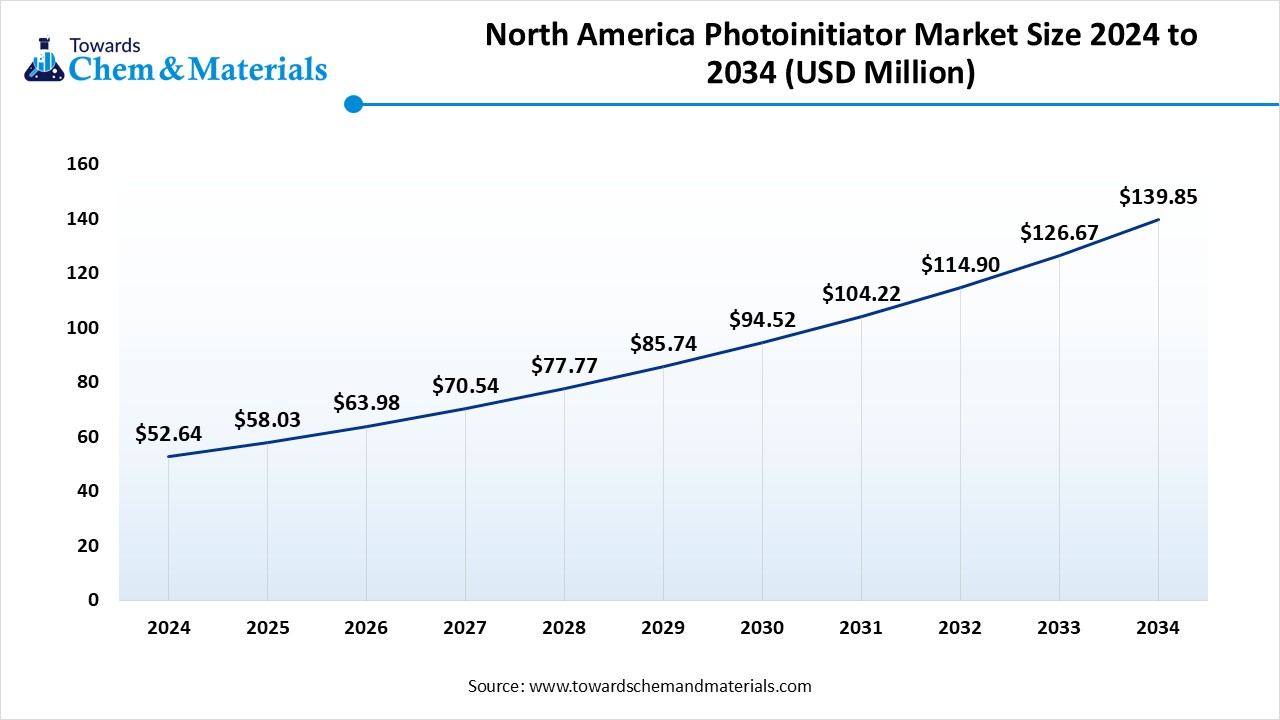
The US String Regulatory Supports and Domestic Production Drive the Growth of the Market
The US has experienced a significant growth in the photoinitiator market, the growth is driven by the string regulatory supports and government regulations for promotion of low-VOC and eco-friendly materials for increasing adoption of UV-curing solutions due to rising environmental concerns and shift towards sustainability and environmentally friendly use of materials drives the growth of the market in the country. The growth is also driven by the strong and key manufacturers in the US, also ensures a reliable supply chain and easy access for photoinitiator to the industries, which boosts the growth of the American market and also supports the expansion of the market.
Asia Pacific Growth is Driven by the Rapid Industrial Manufacturing Sector
Asia Pacific is expected to experience significant growth in the photoinitiator market in the forecast period. The region is seen and experiencing steady growth in the market, the growth is driven by the rapid industrial expansion and expansion of manufacturing units, which increases the demand for products from industries like packaging, electronics, and automotive, fueling the growth of the market. The growth is driven by the rapid industrialization and urbanization, which creates strong demand for photoinitiator along with cost-effective manufacturing processes and solutions.
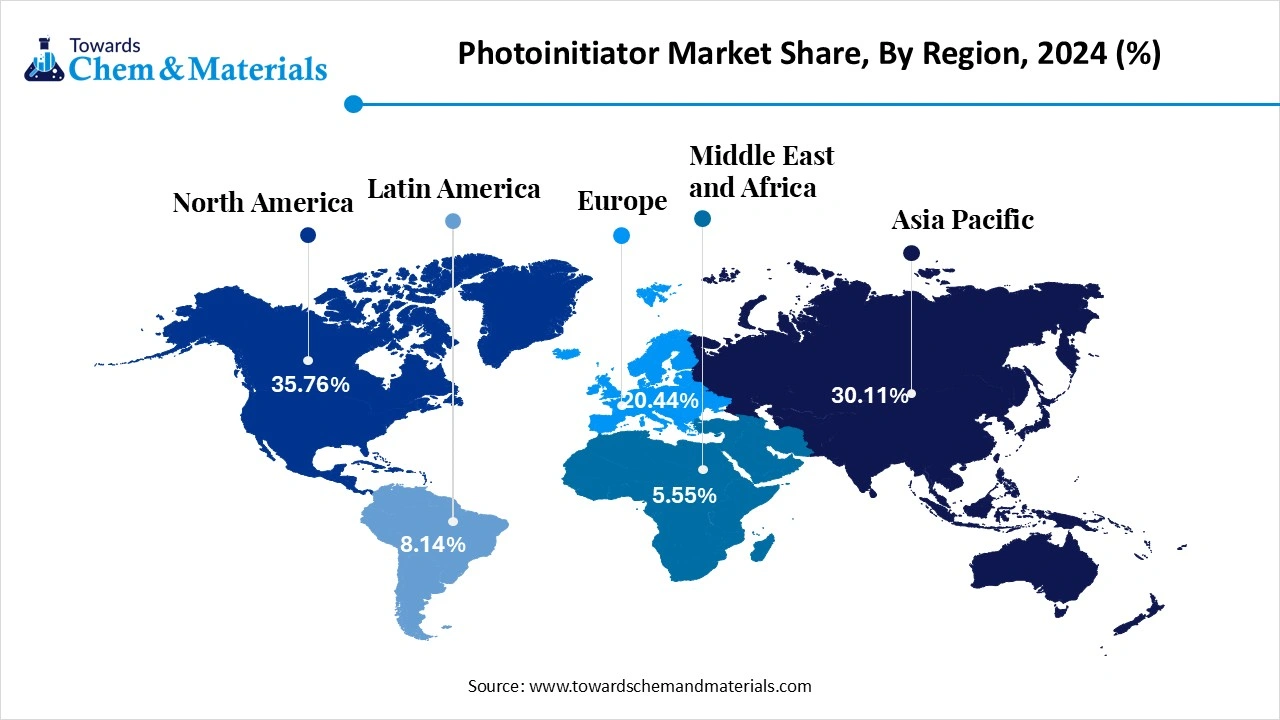
China is a Leading Exporter Of Photoinitiator, Driving the Growth of the Market
China has seen steady growth, driven by the robust industrial sector, which increases the demand for UV curing process materials, and the driving adoption of advanced manufacturing technologies fuels the growth of the market in the country. Major players like Zhejiang Yangfan New Materials Co., Ltd, Tianjin Jiuri New Materials, and Changzhou Tronly New Electronic Materials Co., Ltd, in the country play a significant role in the growth and expansion of the market in the country.
Which Type Segment Dominated the Photoinitiator Market In 2024?
The free radical segment dominated the photo initiator market in 2024. The are molecules that, when exposed to light, like UV or visible it, break down into free radicals, which then perform polymerization reactions. These free radicals are reactive species that play a vital and crucial role in the curing process for various applications like coatings, 3D orienting, and adhesives, which increases the demand for the market due to increasing demand from the industries. They are in high demand due to their advantages, like speed, energy efficiency, reduced VOC, and precise control, which supports the growth of the market. A variety of applications UV curing, coating inks, adhesives, dental materials, and 3D printing, microelectronics in drug microencapsulation, and other medical applications, drive the growth of the market and support the expansion of the market.
The cationic segment is expected to experience significant growth in the photoinitiator market during the forecast period. The cationic photoinitiators are used in various applications like coatings, adhesives, and printing inks as they are used in UV-curing processes to harden and solidify materials fuels the growth of the market. They are used in applications such as food packaging, dental materials, medical devices, and electronic materials where there is a need, and with advantages like strong adhesion, high gloss, chemical resistance, oxygen inhibition resistance, oxygen inhibition resistance and low shrinkage post-cure reaction, versatility, and LED compatibility offering energy efficiency and environmental benefits boosts the growth of the market and also helps in expansion of the market.
How Did the Coating Segment Dominate the Photoinitiator Market In 2024?
The coatings segment dominated the photoinitiator market in 2024. The growth of the market is driven by the growing applications of photoinitiator for a wide range of coatings, like general coatings, wood, metal, and plastics coatings, for specialty coatings like gel nails, which drives the growth of the market. They are crucial for UV curable coatings, which activate rapid and efficient hardening of the coating by the UV curing process. Their wide range of properties and advantages, like high mechanical properties, compatibility with chemicals, and solvent-free chemicals, which increases their demand for coating of various materials for protection and enhancing appearance, boosts the growth of the market, supporting the expansion.
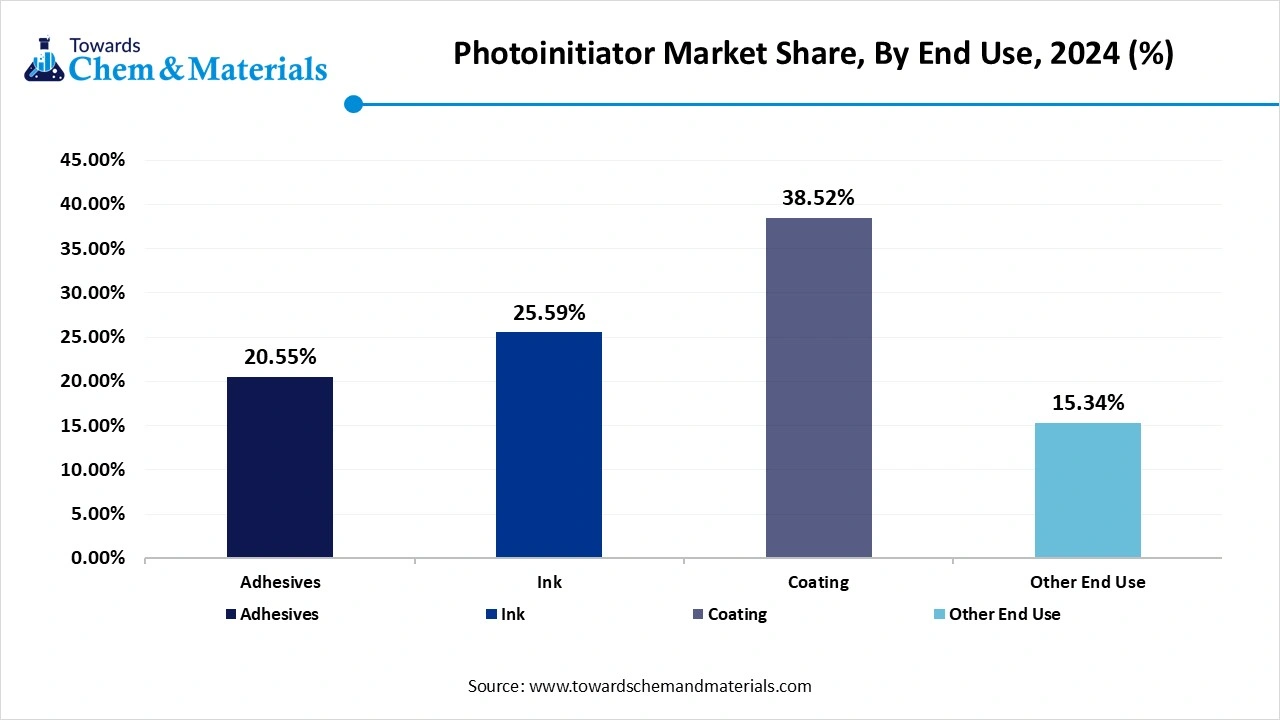
The inks segment expects significant growth in the photoinitiator market during the forecast period. The growth of the market is driven by their properties of fast drying, UV curing, low energy consumption, compatibility with chemicals, and offering of resistance to abrasion ink formulations, which fuels the growth of the market. The growth of the market is also driven by the vital applications like labels, flexible packaging, food packaging, shrink sleeves, and many more. These applications further support the growth of the market and also support and boost its expansion of the market.
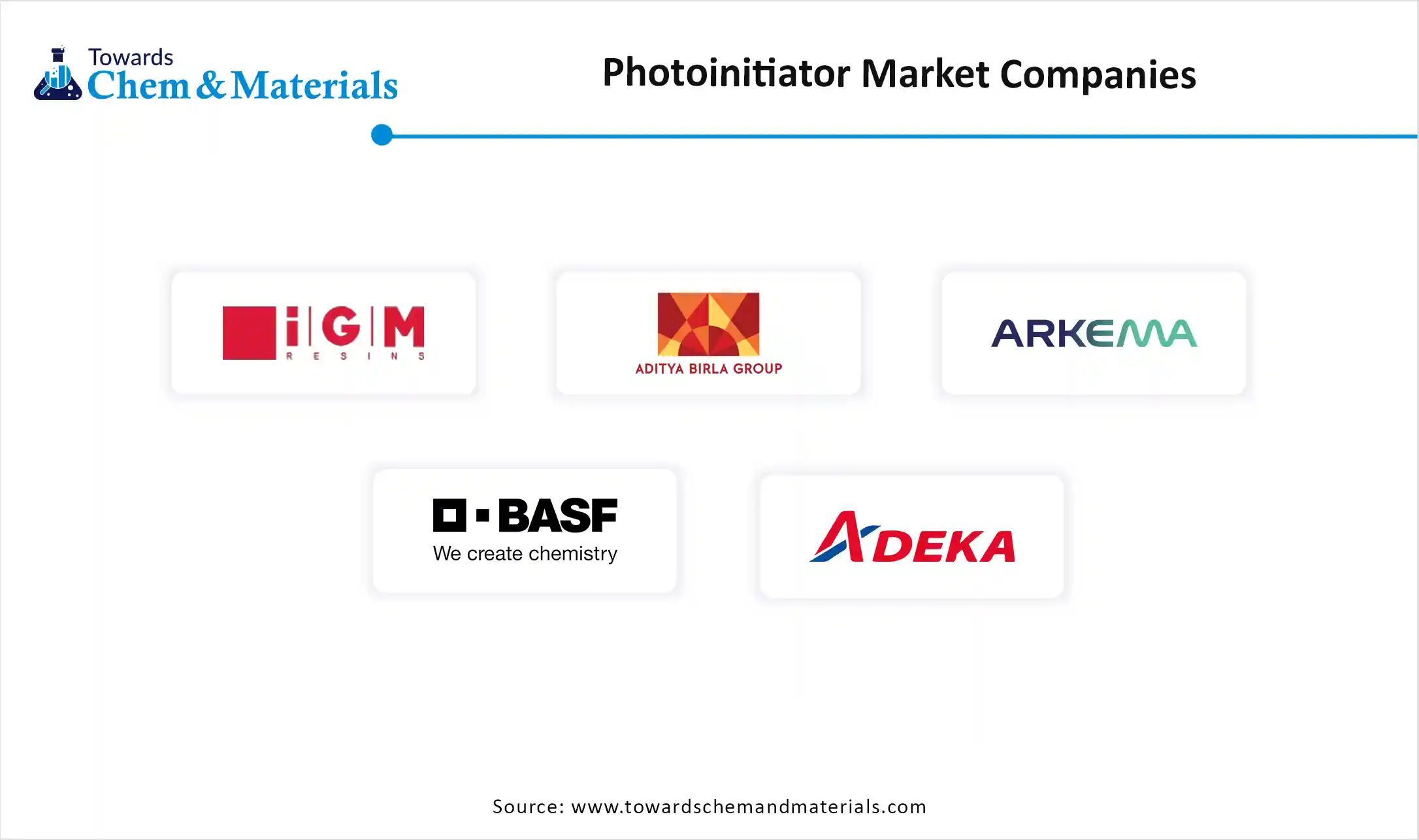
By Type
By End Use
By Region
November 2025
November 2025
November 2025
November 2025